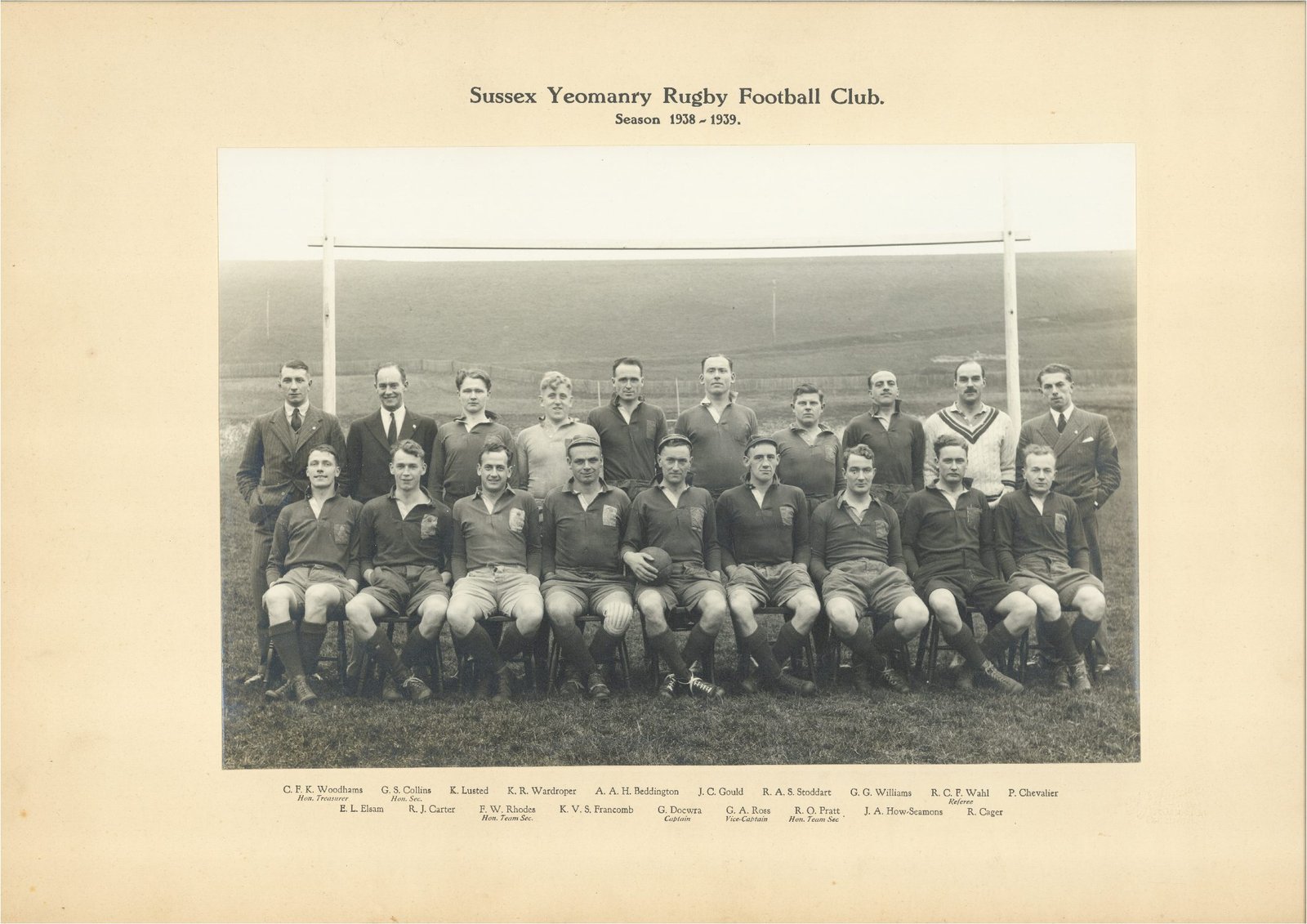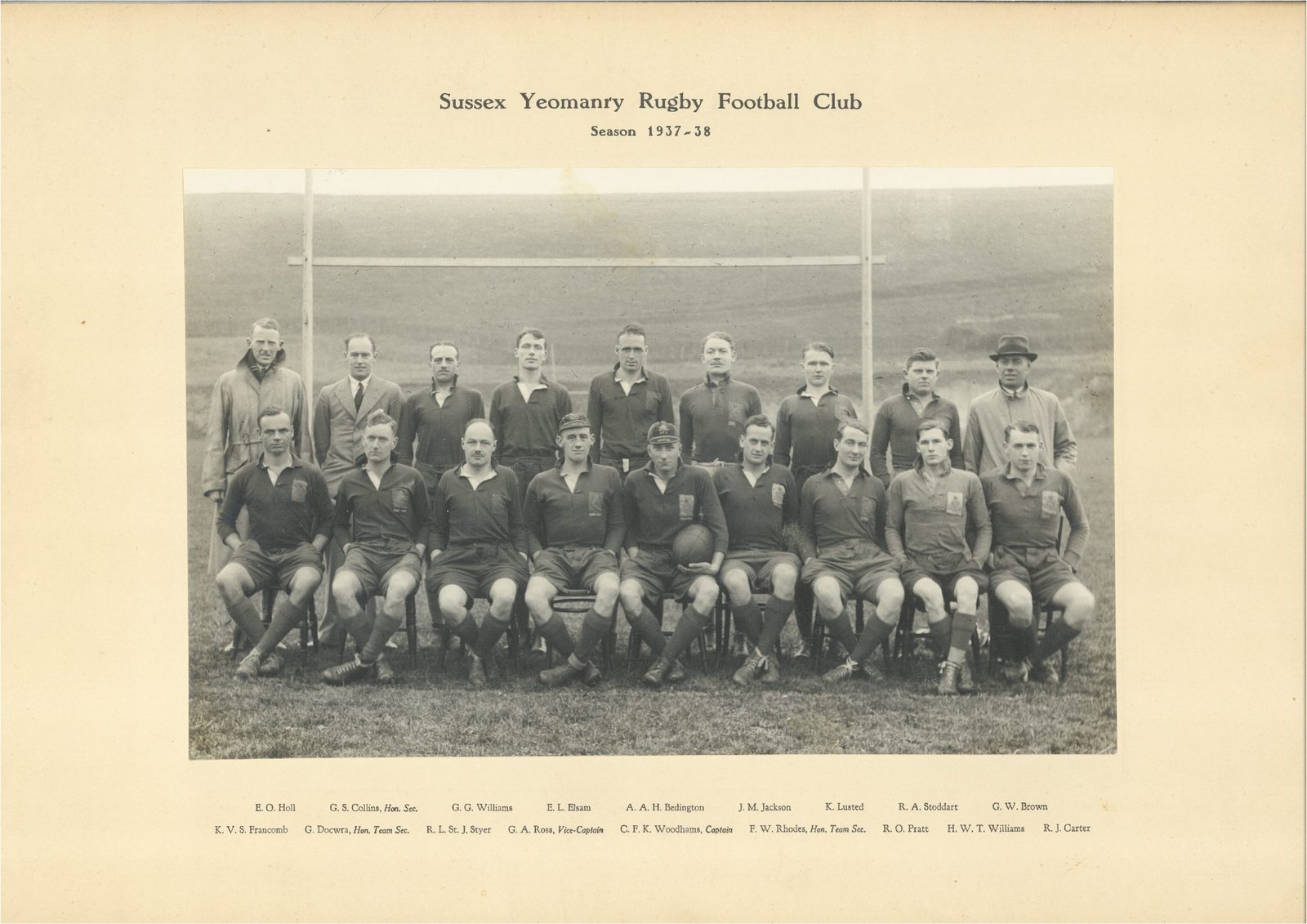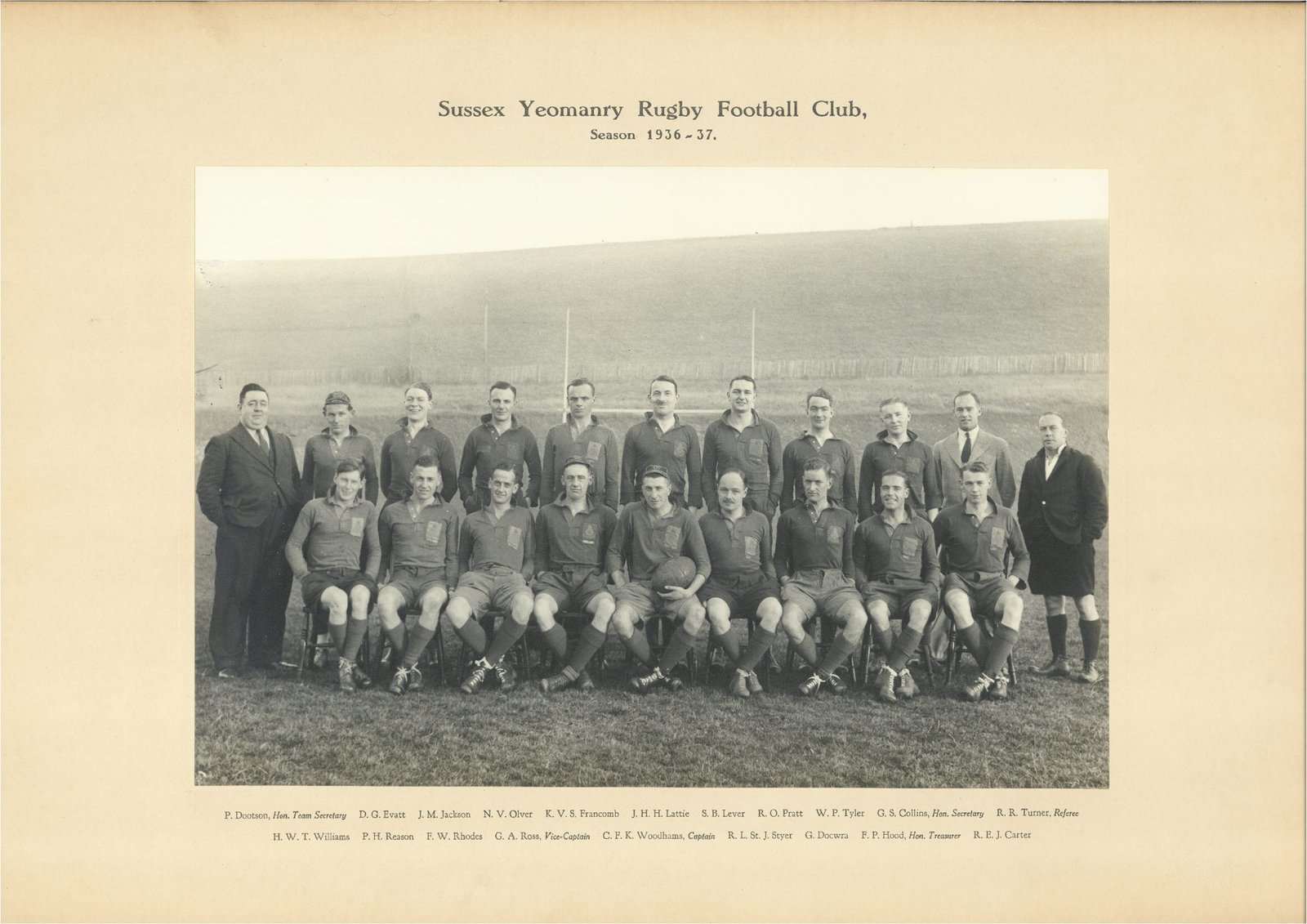Sussex Yeomanry 1938-1939 according to my information was the sixth season for the Yeomanry. As…
The 1930s and 1940s Overview
Club History Article – 1930’s and 1940’s Extract
I have taken an article written by Graham French for the opening of the new Clubhouse in 2002-2003 season and extracted each portion relevant to the decade.
Nearly Seventy years ago Territorial Army Officers and men of the Sussex Yeomanry formed a rugby club which was affiliated to the Rugby Football Union in 1933.
Records of their results have been lost in the mists of time but, post war in 1945 the players reformed and continued to turn out on Saturdays, the home matches being played at East Brighton Park. There is a picture lurking in a corner of the clubhouse of the Sussex Yeomanry RFC circa 1947-1950 of the late John Shelton, former President of Hove RFC and other founder members.
Acknowledgements
I am indebted to David Docwra for all the 1930s information mainly from the legacy of his father the late Geoffrey Docwra. Similarly, I am indebted to Jonathan Boreham for all the 1940s information mainly from the legacy of his father the late Jonathan Boreham Senior.
I must also thank Chris Jenkins for his clipping of the Yeomen vs East Grinstead in which his father Geoffrey Jenkins is mentioned.
Teams
The Yeomanry only ever put out a single XV according to all information that I have received.
Alumni
I have not been made aware of any Sussex Yeomanry player who also played at a higher level. But, if you know better then please do contact me.
Governance
The Sussex Yeomanry Club had only one general committee to run the operation.
Sussex Yeomanry History

It is quite well known that Hove Rugby Club was founded out of the ashes of the Sussex Yeomanry Rugby Club and that the SYRC had a short existence from 1933 to 1939 when WW2 interfered with life.
I have found the following precis of the Sussex Yeomanry Regiment which may be of interest.
The Sussex Yeomanry was a yeomanry regiment of the British Army formed in 1794, with its last remnants disbanding finally in 1999. It was initially formed when there was a threat of French invasion during the Napoleonic Wars. In accordance with the Territorial and Reserve Forces Act 1907 which brought the Territorial Force into being, the TF was intended to be a home defence force for service during wartime and members could not be compelled to serve outside the country.
However, on the outbreak of war on 4 August 1914, many members volunteered for Imperial Service. Therefore, TF units were split in August and September 1914 into 1st Line (liable for overseas service) and 2nd Line (home service for those unable or unwilling to serve overseas) units. Later, a 3rd Line was formed to act as a reserve, providing trained replacements for the 1st and 2nd Line regiments.
The 1st Line regiment was mobilised on 4 August 1914 at the outbreak of the First World War and was in the Canterbury area (under Second Army of Central Force) until September 1915. It was dismounted and left Kent for Liverpool; on 24 September it boarded RMS Olympic and sailed the next day. It arrived at Lemnos on 1 October. The regiment landed in Gallipoli on 8 October and was attached to the 42nd (East Lancashire) Division.
Within days of the landing the Regiment reported many men suffering from enteritis. While at Gallipoli they spent time in the trenches at Border Barricade and Fusilier Bluff. On 30 December it was evacuated to Mudros with 42nd Division; it left the Division at Mudros on 2 January 1916. The brigade, with the regiment, was withdrawn to Egypt in February 1916 and formed part of the Suez Canal Defences.
On 22 February, South Eastern Mounted Brigade was absorbed into the 3rd Dismounted Brigade (along with the Eastern Mounted Brigade). The brigade served as part of the Suez Canal Defences from 14 March to 26 July attached to 42nd (East Lancashire) Division; it then joined the Western Frontier Force. By the end of the year, it was back on the Suez.
With the 74th Division, the battalion took part in the invasion of Palestine in 1917 and 1918. It fought in the Second and Third Battles of Gaza (including the capture of Beersheba and the Sheria Position). At the end of 1917, it took part in the capture and defence of Jerusalem and in March 1918 in the Battle of Tell ‘Asur. On 3 April 1918, the Division was warned that it would move to France and by 30 April 1918 had completed embarkation at Alexandria. In May 1918, the battalion landed at Marseilles, France with 74th (Yeomanry) Division.
It served in France and Flanders with the division for the rest of the war. By 18 May, the division had concentrated around Rue in the Abbeville area. Here the dismounted Yeomanry underwent training for service on the Western Front, particularly gas defence. On 14 July 1918 the Yeomanry Division went into the line for the first time, near Merville on the right of XI Corps. From September 1918, as part of III Corps of Fourth Army, it took part in the Hundred Days Offensive including the Second Battle of the Somme (Second Battle of Bapaume) and the Battles of the Hindenburg Line (Battle of epehy).
In October and November 1918 it took part in the Final Advance in Artois and Flanders. By the Armistice it was near Tournai, Belgium, still with 74th (Yeomanry) Division. With the end of the war, the troops of 74th Division were engaged in railway repair work and education was undertaken while demobilisation began. The division and its subformations were disbanded on 10 July 1919.
Sussex Yeomanry Rugby Club
The Sussex Yeomanry cap pictured below and now on display at the Clubhouse was issued to Geoffrey Docwra who played for the Yeomanry, was a Team Secretary, achieved his cap in 1937-1938 and was captain of the SYRFC team in 1938-1939.

The Yeomanry played their home games in East Brighton Park and their colours were: Blue Vests with Gold Crest. Blue Shorts. Gold Stockings.
We are all aware of the events that began on 1st September 1939 when Hitler invaded Poland and 2 days later France and Britan declared war against Germany in support of Poland.
The result of that, with regard to the Yeomanry, was that it had to disband and muster for the war effort. At the end of the war, it reformed for a little while but struggled to find numbers.
That, of course, led to the creation of Hove Rugby Club in 1952. You can read a bit more about that in Graham French’s words below.
However, according to what I have been told, the Yeomanry formed in 1933 but the items from David only start in 1934 – possibly, his father Geoffrey didn’t join until then. But, if anyone has any information or artefacts for that first season – a fixture card would be brilliant – that would be most helpful.

The Post War XV
As part of the artefacts that I have been given I have discovered that there was an entity that started in 1946-1947 and continued until 1950-1951. I have sourced this information from the scrap books of Jonathan Boreham Senior. Prior to Hove Rugby Club being formed by Boreham Senior and others in 1952 there are a few artifacts relating to the post war resurrection of the Sussex Yeomanry that was mentioned in Graham French’s article.
I don’t have much information – just a few photos and some writing on the back of one that is difficult to read. I won’t create different pages for each season unless I get more information about this period . The second paragraph of Graham French’s article in the Hove Rec Opening Day programme (reproduced below) gives some support to this theory.
I will scan the reverse of the photograph with writing and maybe others of you can make our more detail than I – but the table below contains my interpretation.
The final column in the table headed “Number” – I am unclear about. There is no detail regarding the number. It could be number of games or wins or appearances – let me know if you know more.
| Season | Captain | Number |
|---|---|---|
| 1946-1947 | Francombe | 4 |
| 1947-1948 | Ross | 7 |
| 1948-1949 | Lindon | 8 |
| 1949-1950 | Boreham | 12 |
| 1950-1951 | Boreham |
The two images below show the team in a year unknown and the reverse of the photo gives the game away of a team in that period. If I had to guess I would say this must be the 1950-1951 team unless they wrote on the back of the same photo year after year!
| Season | Front | Reverse |
|---|---|---|
| 1950-1951 (Guess) |  |  |
Below, we have team shots of other years but only one is known for certain – that of 1948-1949 (the photo is dated on the back!). We only show the reverse for those photos with something written on the back.
Points
From March 1905, a try was worth 3 points. A goal from a try (in which case the try didn’t count) was 5 points. A dropped goal (except from a mark or penalty kick) was 4 points. A goal from a mark or penalty kick was 3 points.
In March 1948 a try remained at 3 points, but if you scored a goal from the try then the goal was attributed as 5 point but the value of the try was then zero. A goal from a free kick or penalty kick was 3 points. A dropped goal otherwise obtained was also 3 points.
Nothing like making it simple eh!
The Start of Hove as a Rugby Club
The article below is reproduced from the brochure when the Club moved from Hove Park to Hove Recreation Ground in 2002. It was authored by Graham French.
Territorial Army officers and men of the Sussex Yeomanry formed a rugby club, which was affiliated to the Rugby Football Union in 1933. Records of their results have been lost in the mist of time and the Club disbanded at the outset of the second world war.
After the war, some of the original members together with returning ex servicemen got the Club going again and enjoyed several seasons playing in East Brighton Park. Gradually, it became evident that the Club could not continue as the Sussex Yeomanry and so it was that Hove Rugby Club came about.
It is a truism that from small beginnings spring successful ventures and when Jonathan Boreham, supported by 12 prospective founder members approached the late Alderman Brock (then Mayor of Hove) for assistance in finding a playing pitch in Hove Park, this was readily forthcoming and the new Club was born. Brock and Boreham became its first President and Captain and a tradition of vision, energy and self help has been maintained.
There was a picture lurking in a corner of the old clubhouse of the Sussex Yeomanry RFC circa 1947-50 of the late John Shelton, former President of Hove Rugby Club, and other founder members. [Editors Note: The photo further above labelled 1950-1951 may be the one to which Graham refers. As you can see by from the reverse, John Shelton is the 7th from the left as we look at it]
I have just received some further information in that Graham French’s father was also a member of the Sussex Yeomanry and the Sussex Yeomanry RFC. John French was Lieutenant Colonel at that time.
I will try and find out more info and see when John played for the SYRFC. I hear that Graham joined Hove when he was 15 which would have been around 1962.
Hove Rugby Club
And so, after a lot of effort we are now in 1952 and the Club is formed. Please view the season pages for the detail.











Comments (0)